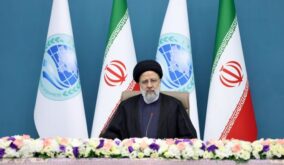Radiofarda – The Islamic Republic of Iran continues to witness a rise in the amount of seized opium and opiates such as heroin or morphine, owing largely to its locationon the Golden Crescent, a drug pathway leading fromAfghanistan and Pakistan through Iran to Europeanmarkets.
This pathway is integral to the issue of drug abuse in Iran, which is often centred on the use of opium and its derivative substances.
Other reports say Iran’s drug policy is failing to grasp the significance of this public health crisis; an immense challenge hard to tackle.
According to the United Nations Office on Drugs and Crime (UNODC), Iran has seized almost 529 thousand kilograms of opium in 2016 alone, making it the country with the largest amount of seized opium in the world.
The 2018 World Drug Report published by the UNODC also shows that Iran is the world’s second country in the amount of seized heroin, with the government seizing over 21 thousand kilograms of heroin in 2016.
While both of these substances are derived from the poppy straw of the opium plant, it is heroin which remains the drug of choice to a majority of Iranian drug uses, says the report.

Campaign Against Drug Addiction In Iran has Failed – Minister
According to research carried out by the Iranian Drug Control Organization, out of the total 2.8 million drug addicts in Iran, 67% use heroin or some other forms of refined opium. While the widespread use of heroin may be caused by its highly addictive nature, it is also very likely that its popularity is due to the sheer amount of opium circulating in the country.
With that in mind, the large amount of opium moving through the country also results in the drug’s low price. According to UNODC statistics from 2009, a gram of heroin can be bought for less than 2 US dollars. In comparison, the typical price of a gram of heroin in the United States ranges from 34 dollars up to 40 dollars.
Despite the government’s efforts to capture drug traffickers at the borders with Afghanistan and Pakistan, as shown by both the number of drug seizures but also the frequent violent clashes between armed forces and drug traffickers in the Sistan-Baluchistan province, its policy towards drug users has proven thoroughly unsuccessful.
Indeed, Abdol Reza Rahmani Fazli, Iran’s interior minister, said during the 61st session of the UN Commission on Narcotic Drugs in Vienna, “It is unbelievable that we have been incapable to control 3 percent of the population who use narcotic drugs?”
Fazli has described Iran’s campaign against drug addiction as a “vicious cycle” where most drug users quickly return to drugs. Indeed, this “vicious cycle” could be partly attributed to the oppressive policy of Iranian authorities.
According to the Interior Minister, up to 43% of Iranian prisoners have been imprisoned for drug-related charges. This clearly shows that drug users in Iran are perceived as criminals by the authorities, instead of being victims of their addiction who need rehabilitation and support. By doing so, the users enter this “vicious cycle” which throws them into poverty and prisons.

Iran Struggles To Deal With Its AIDS Problem
Yet the implications of drug use in Iran are not only limited to the abuse of opium and the imprisoning of many of its users. While methamphetamines constitute only 8% of the country’s drug consumption, they became integral to Iran’s drug culture, the Iranian Drug Control Organization maintained.
According to UNODC, Methamphetamines or, in Farsi, Shisheh, are often used as a supplementary substance to opiates, either as substitute for heroin or a way how to avoid heroin’s severe withdrawal symptoms.
This highlights the problematic nature of Iranian drug policy, which seeks to punish the user. Mohammad Bakhshandeh, the chief of the Drug Police of Greater Tehran, has said that the whole policy needs restructuring.
“If we have accepted the fact that addicts are not criminals and consider them as sick individuals, we should also accept that it is municipal and health departments duty to look after them, not the police’s,” he said, describing the disorganized policy where the policies of individual offices do not pursue one collective aim.
Meanwhile, Moreover, drug abuse in Iran has a significant gender dimension. According to statistics published by The Washington Post in 2014, 350 thousand women were addicted to drugs in 2012, a number which doubled to 700 thousand by 2014.
Although heroin is again the chief substance used by these women, methamphetamines have been reported as a widely used drug by female addicts. Indeed, some reports have gone to the extent as saying that some Iranian women now use methamphetamines to lose or maintain their weight. This drug abuse is often carried out in female-only environments such as beauty salons, which makes it difficult to monitor.
Akin to the government’s treatment of the growing HIV epidemic, Iran’s drug policy is failing to grasp the significance of this public health crisis. While officials have called for reform, it is clear that a well organised policy should have been implemented much earlier. Indeed, drug use has permeated through Iranian society and will prove to be an immense challenge for the government to tackle.
 Shabtabnews In this dark night, I have lost my way – Arise from a corner, oh you the star of guidance.
Shabtabnews In this dark night, I have lost my way – Arise from a corner, oh you the star of guidance.


